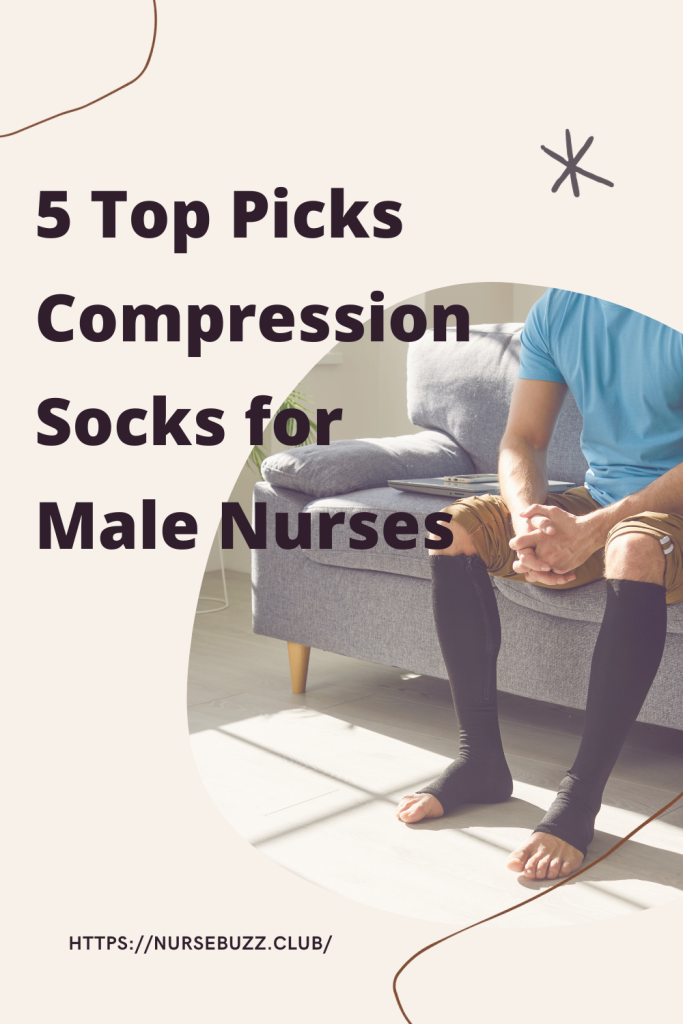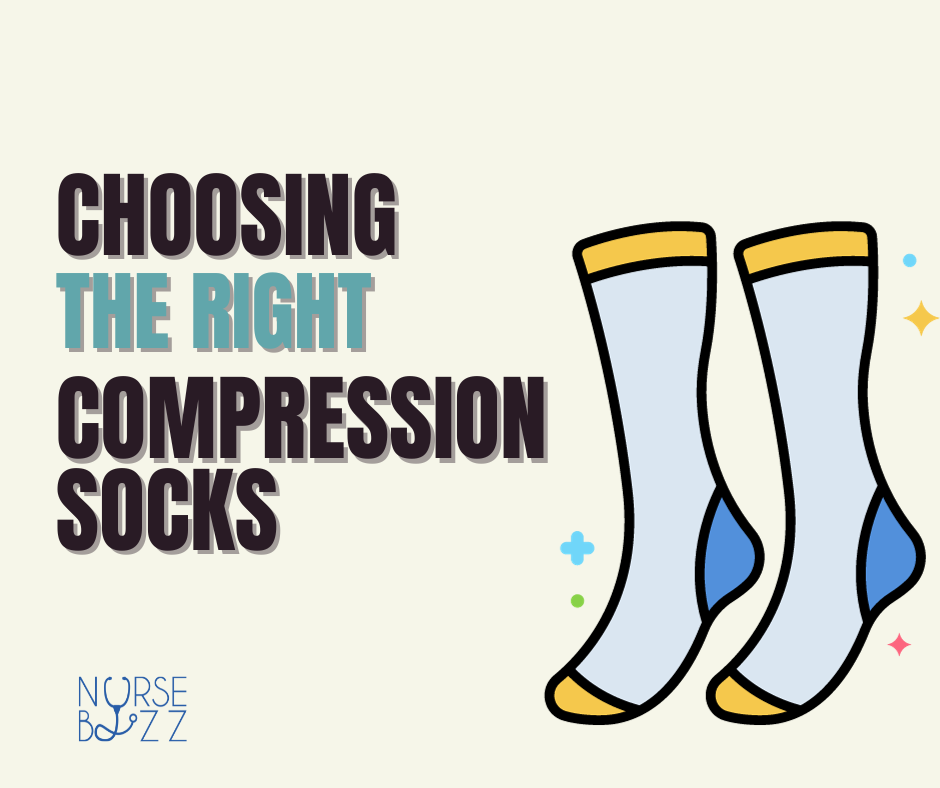Discover the ultimate selection of male nurses compression socks. Our comprehensive guide helps you find the perfect compression socks to support your shifts.
Wearing the right male nurse compression socks can be a game-changer in your demanding profession. As male nurses, you’re no stranger to the physically demanding nature of your job. Long hours on your feet, constant movement, and the need to be at your best throughout your shift can take a toll on your legs and feet. This is where compression socks for male nurses come to the rescue. They offer much-needed support and comfort, reducing fatigue and the risk of specific health issues. However, it’s important to note that not all compression socks are of the same quality, and that’s where this guide can be valuable.
1. Understanding the Needs of Male Nurses
Before diving into the world of male nurse compression socks, it’s crucial to recognize the unique challenges male nurses face. The physical rigors of the nursing field can place a notable strain on male nurses, potentially resulting in various concerns like leg pain, swelling, and, in some cases, the development of varicose veins. These challenges are often exacerbated by the long hours spent on one’s feet, the constant movement required, and the need to be at your best throughout your shift.
The Struggles Male Nurses Face
Male nurses often engage in physically demanding work, which places added stress on their lower extremities. This, in turn, can result in discomfort and health issues that affect their job performance and overall well-being.
Leg Pain: Prolonged periods of standing and walking can lead to persistent leg pain. Over time, this discomfort can become a chronic issue, affecting the quality of life during and after work.
Swelling: Swelling, especially in the ankles and lower legs, is a common problem for male nurses. It’s not only uncomfortable but can also indicate poor circulation.
Varicose Veins: Elevated pressure on the legs can contribute to the formation of varicose veins, which not only have an unsightly appearance but can also be accompanied by discomfort.
The Role of Compression Socks

Best compression socks come to the rescue in this situation. These specialized garments are tailored to deliver graduated compression, with a tighter fit around the ankle that gradually eases as they ascend the leg. This design aids in improving circulation, effectively countering male nurses’ challenges.
Improved Circulation: Compression socks for male nurses aid in enhancing the efficiency of blood circulation from the legs to the heart, thereby diminishing the risk of blood pooling and the onset of varicose veins.
Targeted Support: The socks offer targeted support to the muscles in your legs, reducing the strain on your limbs and making it easier to withstand the physical demands of your job.
Reduction in Leg Pain and Swelling: By providing consistent support, compression socks can help alleviate leg pain and reduce swelling, making your long shifts more comfortable.
2. Choosing the Right Compression Socks

Choosing the most suitable compression socks is not a one-size-fits-all endeavor. To ensure the best decision, it’s crucial to consider a variety of factors that align with your individual requirements. The right compression socks can make a difference in your comfort and overall well-being during your demanding nursing shifts. To assist you in making an informed choice, let’s delve into the specifics of the critical aspects you should consider:
Compression Level:
Compression socks come in different compression levels, typically measured in millimeters of mercury (mmHg). The right compression level depends on your specific needs and comfort preferences. Here’s a breakdown of the standard levels:
- Mild (8-15 mmHg): Suitable for mild discomfort, fatigue, and prevention of varicose veins.
- Moderate (15-20 mmHg): Ideal for mild to moderate swelling and discomfort.
- Firm (20-30 mmHg): Recommended for moderate to severe swelling and varicose veins and often used for therapeutic purposes.
- Extra Firm (30-40 mmHg): Prescribed for severe edema, chronic venous insufficiency, and other medical conditions. Consult a healthcare professional before using this level.
Material:
Male nurse compression socks are available in various materials, including cotton, nylon, and microfiber blends. Each material has its unique characteristics:
- Cotton: Known for its breathability and comfort, cotton is a good choice for those who prefer natural fibers.
- Nylon: Nylon socks are durable, provide excellent compression, and are often used in athletic and medical settings.
- Microfiber Blends: These materials offer a combination of comfort and durability, making them a popular choice among nurses.
Size:
Selecting the right size is critical to ensure that the best compression socks fit properly and provide the intended benefits. Socks that are too loose won’t provide adequate compression, while those that are too tight can be uncomfortable and restrict circulation. Manufacturers typically provide sizing charts to help you find the perfect fit based on your shoe size and calf circumference.
3. Top Picks Compression Socks for Male Nurses
When it comes to finding the perfect male nurse compression socks for your demanding role as a male nurse, the options are abundant, and choosing the right pair can be a daunting task. To simplify your search, we’ve done the research and compiled a list of top picks that have gained recognition among male nurses for their exceptional performance. Here’s a closer look at our carefully curated selection:

Key Features:
- 75% Nylon, 25% Polyester blend
- Imported for quality
- Pull-On closure for convenience
- Machine washable
- Compression technology with copper fibers for improved blood circulation
- Designed for sports and exercise
- Breathable, moisture-wicking fabric
- Available in two sizes
- Ideal gift for various recipients
- Comes with a 100% service guarantee
2. Compression Circulation Socks 3 Pairs
Key Features:
- 85% Nylon, 15% Polyester for durability and flexibility
- Fun mismatched designs in various colors
- Graduated compression (20-30 mmHg) recommended by doctors
- Enhanced support with reinforced toe and heel
- Suitable for various activities and work profiles
- Moisture-wicking and breathable fabric
- Great gift idea for athletes, travelers, and those on their feet all day
3. Compression Socks 20-30mmHg Support
Key Features:
- Material: 72.1% Polyamide, 18.4% Polyester, 9.5% Spandex
- Sizing Options: Available in S/M (calf size 9-15in) and L/XL (calf size 14-16in)
- Moisture-wicking and breathable for dry, comfortable wear
- Friction and shock protection with seamless toe and cushioned sole
- Graduated compression for improved circulation and muscle support
- Suitable for both women and men, ideal for various activities
- Lifetime service commitment for customer satisfaction.
4. Laite Hebe 6 Pairs Compression Socks

Key Features:
- Material: 85% Nylon, 15% Polyester
- Imported for quality
- Pull-On closure for convenience
- Revives and energizes legs, offering pain relief and improved circulation
- Graduated compression technology for all-day comfort
- Four pairs of flexible and durable unisex socks
- Suitable for various activities and lifestyles
- Satisfaction guarantee for a risk-free purchase.
5. Compression Socks for Circulation
Key Features:
- Material: 85% Nylon, 15% Polyester with copper-infused fibers
- Imported for quality
- Promotes circulation and relieves pain
- Graduated compression for leg health
- Value 6-pack at an affordable price
- Suitable for daily wear and various conditions
- Great gift idea with universal applicability
- Satisfaction guaranteed with a risk-free exchange or refund policy.
4. Benefits of Wearing Compression Socks
Wearing compression socks for nurses is not just a fashion choice; it’s a wise decision that can significantly enhance your comfort, health, and overall performance as a male nurse. Here, we’ll delve into the multitude of benefits these specialized socks offer, showcasing how they can be a game-changer in your daily nursing routine.
- Improved Blood Circulation: One of the primary benefits of compression socks is their ability to enhance blood circulation. They work by applying gentle, consistent pressure to your legs, which helps blood vessels operate more efficiently. This, in turn, reduces the risk of blood pooling in the lower extremities and improves overall circulation.
- Reduced Swelling: Compression socks effectively combat swelling, particularly in the ankles and lower legs. They promote the movement of fluids, preventing them from accumulating in tissues and causing discomfort.
- Varicose Vein Prevention: Varicose veins are a common concern for individuals who spend extended periods on their feet. Compression socks for nurses can help prevent their development or minimize their appearance by providing consistent support to the blood vessels.
- Alleviated Leg Pain: Long shifts can take a toll on your legs, leading to discomfort and pain. Compression socks reduce muscle vibration and minimize the strain on your limbs, offering relief from leg pain.
- Enhanced Energy Levels: Improved circulation and reduced leg fatigue contribute to an increase in overall energy levels. As a male nurse, this boost in energy can make a substantial difference during your demanding shifts.
- Blood Clot Prevention: Prolonged periods of inactivity and standing can increase the risk of blood clots, especially in the lower extremities. Best compression socks help prevent this by encouraging blood flow and minimizing the potential for clot formation.
- Decreased Muscle Soreness: The targeted support provided by compression socks can reduce muscle soreness and stiffness. This makes it easier to recover after a long day on your feet.
- Enhanced Comfort and Support: The sheer comfort and support offered by compression socks can’t be overstated. They fit snugly, providing a feeling of security and reducing the strain on your legs and feet.
- Style Options: Don’t think that functionality means sacrificing style. Many compression sock brands offer a range of colors and patterns, allowing you to add a personal touch to your uniform.
Read About: How to Become a Nurse with Bad Grades
5. Why Compression Socks May Cause Leg Discomfort

Experiencing leg discomfort or aching after wearing compression socks can happen for several reasons, and it’s important to understand that it’s not a universal experience. Some individuals may find relief and comfort from wearing compression socks, while others might initially experience discomfort. Here are a few potential reasons for leg discomfort when wearing compression socks:
- Incorrect Sizing: If your compression socks are not the right size or if they are too tight, they can cause discomfort. Proper sizing is crucial to ensure the socks provide the intended benefits without being overly constrictive.
- Inadequate Graduated Compression: Compression socks for nurses are designed with graduated compression, meaning they are tighter at the ankle and gradually loosen as they move up the leg. If the compression level is too high or too low for your specific needs, it can lead to discomfort.
- Improper Donning: Putting on compression socks correctly is essential. If you don’t pull them up evenly or if there are wrinkles or bunching in the fabric, it can lead to pressure points and discomfort.
- Skin Sensitivity: Some people have skin sensitivities, and the material of the socks may cause irritation or itching. Choosing best compression socks made from hypoallergenic or soft materials can help in such cases.
- Intolerance to Compression: In some rare cases, individuals may not tolerate compression well, and they may find it uncomfortable regardless of the sizing or type of compression socks used.
- Adjustment Period: Some people experience discomfort when they first start wearing compression socks. It might take a few days or weeks for your legs to adjust to the pressure and for you to become accustomed to the feeling of wearing compression socks.
- Health Conditions: If you have certain underlying health conditions, such as peripheral artery disease or diabetes, it’s essential to consult with a healthcare professional before using compression socks. These conditions may require specialized socks or specific pressure levels.
If you’re experiencing discomfort when wearing compression socks, it’s advisable to:
- Double-check the sizing and ensure you’re using the correct size for your legs.
- Consider consulting a healthcare professional or a specialist in compression therapy to determine the most appropriate compression level and type of socks for your needs.
- Gradually increase the duration you wear the socks to allow your legs to acclimate to the compression.
6. Conclusion
In the fast-paced world of healthcare, it’s vital to prioritize your well-being. Male nurse compression socks are a small investment with a big impact. They offer the support you need to excel in your career and stay on your feet with confidence.
FAQ of Male Nurses Compression Socks

- Should male nurses wear compression socks?
Absolutely, best compression socks can benefit male nurses by reducing leg pain and swelling, enhancing circulation, and preventing varicose veins.
- Can men wear compression socks?
Yes, compression socks are designed for both men and women. They are available in various styles and sizes to suit everyone’s needs.
- Why should men wear compression socks?
Wearing compression socks can significantly improve comfort during long shifts, reduce the risk of leg-related health issues, and enhance overall job performance.
- What is the recommended compression socks for nurses?
The recommended compression socks for nurses can vary depending on individual needs and preferences. To find the best option for your specific requirements, it’s essential to read the comprehensive guide provided above.




